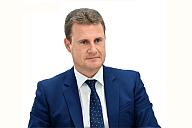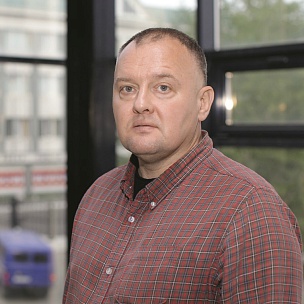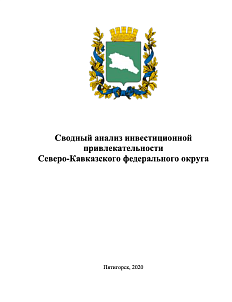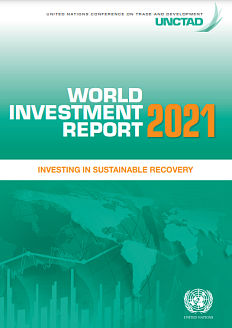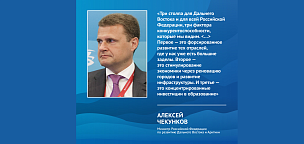Minister for the development of the Russian Far East and Arctic Alexei Chekunkov spoke to the Eastern Economic Forum 2022 magazine about the impact the current political situation is having on the development of the region, the most profitable infrastructure project in Russian history, and a new approach to urban planning.
How has the current geopolitical situation affected the Far East? Has it largely benefited or suffered?
Today, more than 2,700 investors are implementing projects in the Far East using the system of state support measures preferences for advanced special economic zones, the Free Port of Vladivostok, the Arctic Zone of the Russian Federation, infrastructure subsidies, and concessional financing as part of the anti-sanctions package. Real investments in Far Eastern projects have exceeded RUB 2.7 trillion. Moreover, the Far East was almost four times ahead of other regions in 20152021 in terms of growth rates of investment in fixed capital, and more than a third in terms of manufacturing growth. A total of 527 enterprises have already been put into operation, and more than 102,000 new jobs have been created.
This year, due to the actions of unfriendly countries, Far Eastern businesses have faced difficulties disruptions in the supply of equipment, mutual settlements, and a breakdown in logistics chains that have been built up over the years. However, the consistent steps that have been taken to support the economy and the social sector have helped to maintain a balance. Most companies have not given up on implementing projects and continue to invest in the development of the region. For our part, we are trying to help entrepreneurs and we are always in touch twenty-four seven.
I am certain that Russian entrepreneurs will win out in the long run because they will become stronger. After all, a diamond crystallizes under pressure. Today, investors are diversifying both their technological and financial risks. Russian industry has received an additional boost: we are seeing how the process of import substitution is gaining momentum in almost all industries.

Investors remain confident in the Far East. What do you see as the main challenges for the development of the region today? And what mechanisms are being used to address these issues?
Infrastructural constraints are one of the key factors that is holding back the Far Eastern economy and preventing the inflow of foreign investment. Even today, we are seeing a more than 70 million tonne shortage in carrying capacity in eastern Russia in terms of transportation capabilities. In three years, according to our estimates, it could reach 150 million tonnes. This problem will be solved, first of all, by projects that are already underway to debottleneck railway infrastructure, which should be synchronized with the modernization of ports, bridges, border crossings, warehouses, and logistics complexes. This year, two new cross[1]border bridges have opened in the Far East: NizhneleninskoyeTongjiang in the Jewish Autonomous Region and BlagoveshchenskHeihe in the Amur Region. Second, we are counting on large-scale maritime transportation, including the transportation of containerized cargo along the NSR [Northern Sea Route]. At present, together with Rosatom, we are rolling out a regular coastal line. The lighter carrier Sevmorput is running both ways on the St. PetersburgFar East route. Containerized cargo is being transported during the first stage, including for deliveries to the north, but this list will expand in the future.
Another challenge is a lack of human resources. The Far East Development Corporation is implementing a number of programmes to attract specialists from the most in-demand sectors to the region. We are also helping internally displaced persons from Ukraine, the LPR [Luhansk Peoples Republic], and the DPR [Donetsk Peoples Republic] who have decided to move to the Far East to find a job.

We have launched and are implementing the Muravyov-Amursky 2030 management training programme. Admission to the programme is tantamount to admission to the civil service: cadets sign a contract and pledge to work for two years at the federal or regional level of government or at a development institution. The training modules not only involve hands-on training, but also immersion in on-the-job training directly in the territories, working side-by-side with future employers. Working closely on projects together with the current heads of government bodies and development institutions, the cadets not only soak up knowledge, but also the spirit required to work successfully in the Far East and the Arctic. Over the next five years, we will put out 100150 such new managers for the Far East, and it will be a unique cohort.
How are things going overall with the development of the NSR?
The pivot to the East runs through the Arctic. There is simply no other way of organizing the delivery of the quantity of cargo that is already being produced and will be produced in the north in the coming years. The mega-projects that are currently being implemented along the NSR to extract and liquefy gas as well as to extract oil and other minerals alone will ensure a cargo flow of more than 100 million tonnes in 2025.
Based on instructions from the Russian President, the government has approved the Development Plan for the Northern Sea Route for the period until 2035. This is a strategic document that brings together key measures to develop the NSR as a national and international transport artery, create related infrastructure, and ensure safe navigation.
The plan includes 152 projects that aim to develop the export and coastal cargo base, transport infrastructure, and the cargo and icebreaking fleet, as well as manage, develop, and ensure safe navigation along the NSR. Total investment in the development of the NSR until 2035 will amount to almost RUB 1.8 trillion, including RUB 620 billion from the federal budget. This investment will provide more than RUB 16 trillion in taxes to the budget by 2035. The NSR will thus become one of the most profitable infrastructure projects in Russian history.
Russia has been chairing the Arctic Council for a year now. What has and hasnt worked during this time?
Since the start of the chairmanship, over 30 events have been held with the participation of more than 7,000 people from 15 countries. The agenda of forums and conferences includes support for indigenous people, technology development, global warming, security, culture, tourism, and other themes. This year, unfriendly countries have tried to split the Arctic in half with their actions. However, this split is impossible. I am certain that the sanctions agenda will run out of steam sooner or later, and all members of the Arctic Council will have to return to constructive collaboration. We are always open to such work.

Many cities, and Vladivostok in particular, will present their master plans at the EEF. Whats the difference between the new approach to urban development and the previous one?
Historically, Far Eastern cities have originated from prisons and posts created by legendary pioneers. Such settlements, and essentially fortresses, became the outpost of the state in the East. For example, Blagoveshchensk emerged from Zeisky post. Vladivostok post became a city after the decision was made to create a major seaport on the Pacific coast in Primorye. During the Soviet period, Far Eastern cities actively developed around large industrial enterprises. Today, another cycle of their transformation has begun. This time, the main driver behind this process is the need of people to improve their quality of life in almost all areas.

Based on instructions from the Russian president, draft master plans have been developed for urban areas with a population of more than 4.1 million. People can learn more about them at the EEF. We will present master plans for Petropavlovsk-Kamchatsky, Ulan-Ude, and Magadan to the Russian president. The developers asked the residents what they are most concerned about and what new facilities they need above all else. All the cities tried to find their mission, work out a spatial development plan, calculate the growth economics until 2030, and identify the top priority locomotive projects. Together with the governors, who were actively involved in the master planning process, we will fight to bring the urban planning ideas to life.
A year ago, we spoke about the National Programme for the Development of the Far East, which states that the key indicators of peoples lives should grow at a faster pace over the next four years than the rest of Russia. Can these conditions be met? And how?
The Russian president has given instructions to stop the outflow of the population from the Far East by 2035. In 2021, the overall demographic decline in the Far Eastern Federal District decreased by 23.3%. A demographic increase was seen in a number of regions, namely Yakutia, Chukotka, and Kamchatka Region. Last year, for the first time in twelve years, more people moved to the Far East than left the region. The migration influx exceeded 7,400 people.
All these figures indicate that the regions appeal for working and living has improved significantly. This is in part thanks to the system of preferences and social programmes operating in the Far East. For example, a demographic package with higher payments for families with children and a Far Eastern mortgage that allows for improving living conditions with the help of soft loans at 2% per annum.

Despite the positive statistical signals, the negative trends have not yet been finally reversed. But the levers needed to do so have been created. The Russian government has come up with a package of strategic decisions which, in combination with existing state programmes, will accelerate the transition from population decline to population growth. Large-scale projects will be implemented to increase the birth rate, reduce the mortality rate, develop healthcare, attract specialists, improve the quality of general and higher education, develop the urban environment, and renovate Far Eastern cities. I am confident that the decisions and social initiatives adopted at the EEF will further bolster this action plan, and the people of the Far East will feel the effect of this work in their daily lives.


